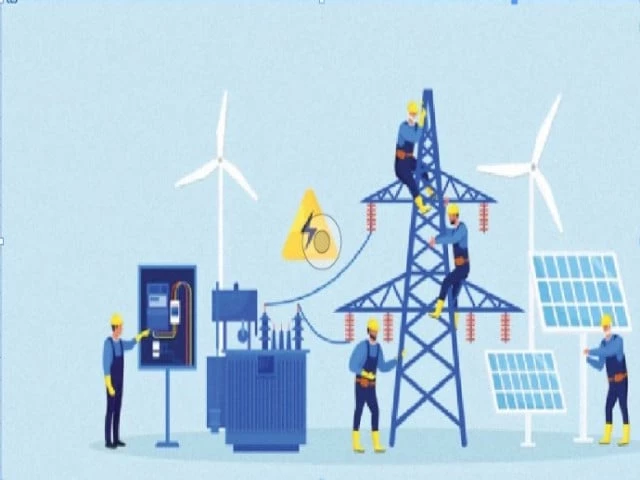Islamabad:
The government has succeeded in restricting the pending contributions from the Economic Corridor Corridor (CPEC) in Chine-Pakistan (CPEC) to 423 billion rupees by June of this year, which could also be settled soon, subject to early resolution of the issue of interest on late payments.
Official documents have shown that at the end of the 2024-25 fiscal year, energy payments pending to Chinese power plants amounted to 423 billion rupees. These were 22 billion rupees, 5.5%, more than the previous year.
Details have shown that since 2017, the country has paid 5.1 billions of rupees in terms of energy in the 18 Chinese power plants, which were equal to 92.3% of the amount billed, including interest. Pakistani authorities believe that the remaining real cost of energy was less than 300 billion rupees and that the rest of the amount was due to late payment supplements.
The Government is taking nearly 1.3 billion of costs of costs of local commercial banks to remove the circular debt which it owes to power plants belonging to the State, nuclear power plants, private factories and Chinese factories.
According to one of the conditions established by the federal cabinet, the authorities will negotiate with electricity producers to renounce payments of interest in exchange for taking payments in advance, said a government official who is one of these discussions.
The Chinese may not give up the cost of interests due to their internal requirements, which would leave the government to the possibility of making complete payments in a sudden or cleaning contributions as the budgetary space is created.
The unpaid debts of 423 billion rupees are in violation of the CPEC 2015 energy framework agreement, which links the government to fully erase contributions, that the authorities can recover the amounts of end consumers.
In addition to security, non-compliance with CPEC contracts is one of the reasons for the slow increase in financial and commercial relations between the two nations. Prime Minister Shehbaz Sharif is expected to visit China next month, and one of the articles on the agenda attracts Chinese investors in Pakistan by responding to their concerns.
Under the CPEC energy framework agreement, Pakistan had to create a renewable fund with 21% of power bills to protect Chinese companies against the circular debt crisis. However, the previous government opened a renewable energy account of Pakistan at the State Bank of Pakistan in October 2022 with 48 billion rupes of annual allowances. But that limited withdrawals to 4 billion rupees per month, leading to the current debt of 423 billion rupees.
The documents show that Pakistan owed 87 billion rupees to the Sahiwal power plant with imported coal, while the company received 1.14 Billion of rupees during the last eight years of its operations. The country also owed 69 billion rupees to the coal Hub Power project, compared to 834 billion rupes of total complaints.
The remaining contributions in suspense of the QASIM Port power plant on coal was 85.5 billion rupees, against total invoices of more than RS1 billion rupees. Contributions from the QASIM port factory were around 15 billion rupees higher than the previous year.
The contributions of the Thar coal project remained at 55.5 billion rupees. He had claimed 566 billion compulsory compulsory rupees. Karo Power Company’s suspended contributions were RS11 billion, Engro Powergen Thar Coal RS38 billion, Matiari Lahore Transmission Line RS28.5 billion and Thar Energy Limited RS8.3 billion.
The Chinese government has repeatedly raised this issue with Pakistan through diplomatic channels, including the Pakistan Embassy in Beijing and its own embassy in Islamabad.
It is expected that once the procedural formalities ended by commercial banks and federal government entities, the amounts of the circular debt would begin to decrease.
The government had concluded an agreement with commercial banks to borrow 1.25 billion of rupees at less than an interest rate of 11% in the context of its three -stea strategy to eliminate the circular debt and restore the viability of the powers sector.
Banks should pay loans shortly after compliance with procedural requirements.
The agreement would be around 3% to 5% cheaper than interest on existing installations and the Penalties that the government pays not to make payments in a timely energy purchases. The debt of 1.25 Billion of rupees is taken in the books of the Central Power Purchase Agency (CPPA), and it would not be part of the global public debt.
The government paid up to 14% of the costs of commercial banks on loans that had taken in the past to withdraw the circular debt, and up to 16% prices for independent electricity producers (PPI) for not having made payments in a timely time.
Of the total of RS 2.4 Billions of existing circular debt stocks, it is necessary to reinstall the main amounts of 1.5 billion of rupees to eliminate the debt stock.
On RS1.25 Billions, around 660 billion rupees will be paid against power with limited debt. This debt had been obtained in the past at a rate of Kibor plus up to 2%. The powers of nuclear power plants will cost around 280 billion rupees, while LNG power plants should receive 220 billion rupees.
The previous efforts of Pakistan to obtain the reprogrammed energy debt did not succeed, according to government sources. The Minister of Finance Muhammad Aurangzeb and the Minister of Energy Sardar Awais Laghari led these efforts.
Pakistani officials had requested an extension of five to eight years for the reimbursement of the energy debt, converting interest payments based on the US dollar to Chinese currency and reducing overall interest rates for projects funded by CPEC and not CPEC.




